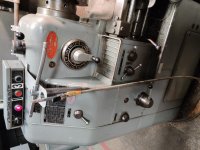Ive only seen one Okuma manual in the flesh and it was a beast, a quality looking machine. Something like this.
I dont suspect itll be much out of level with a monster 1 piece base like that

. But hopefully the manual will spec checking level off unwearing surfaces.
If youre good that way ride a 10-20 sec level up and down the bed on the carriage, pointing inline and across the ways as a quick and dirty check for horrible bed wear.
If that looks good, chuck a 2"-3" slug and turn equal diameter collars over 6" minimum. You can indicate this from the saddle as you would a test bar. Should be 0-0 too 0-pointing towards the operator a smidge.
According to the Okuma pages the HS is adjustable on the LS, which is encouraging.
Keep it simple an take your time, should have a decent idea of whats going on in about an hour or so.
Let us know how you go

Edit:- Ooo forgot to ask which way is the taper going? Fat furthest from the headstock im guessing.


 . But hopefully the manual will spec checking level off unwearing surfaces.
. But hopefully the manual will spec checking level off unwearing surfaces. 
